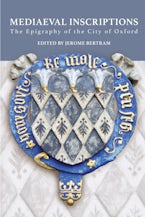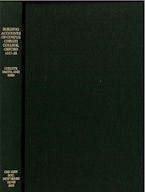
→
Recommend to library
Title Details
492 Pages
21.6 x 13.8 cm
2 b/w illus.
Series: Oxford Historical Society New Series
Series Vol. Number:
49
Imprint: Oxford Historical Society
Minutes of the Oxford Paving Commissioners 1771–1801
- Description
- Contents
- Author
Oxford Town and Gown came together in 1771 as Paving Commissioners, the city's principal local government body. Within thirty years this remarkable collaboration did much to transform Oxford from a medieval to a modern city.
Eighteenth century Oxford was a place of great contrast with the architectural splendour of its university and college buildings set among narrow streets and timber-framed houses. Ancient gates and market stalls obstructed traffic and rubbish piled up in unpaved streets. Neither Town nor Gown could satisfy the growing appetite for urban improvement so they came together after centuries of rivalry in 1771 in a remarkable collaboration to sponsor a Local Act establishing Oxford Paving Commissioners as the city's principal local government body. The commissioners included the vice-chancellor and the mayor, heads of colleges, professors, councillors and local businessmen. A minority of these commissioners used the authority's extensive powers to rebuild Magdalen Bridge and reshape its approaches, abolish street markets, pull down old buildings, and pave, light and cleanse the streets. Some critics regretted these changes, others wanted more, but all could agree that, within thirty years, Oxford had been transformed.
Eighteenth century Oxford was a place of great contrast with the architectural splendour of its university and college buildings set among narrow streets and timber-framed houses. Ancient gates and market stalls obstructed traffic and rubbish piled up in unpaved streets. Neither Town nor Gown could satisfy the growing appetite for urban improvement so they came together after centuries of rivalry in 1771 in a remarkable collaboration to sponsor a Local Act establishing Oxford Paving Commissioners as the city's principal local government body. The commissioners included the vice-chancellor and the mayor, heads of colleges, professors, councillors and local businessmen. A minority of these commissioners used the authority's extensive powers to rebuild Magdalen Bridge and reshape its approaches, abolish street markets, pull down old buildings, and pave, light and cleanse the streets. Some critics regretted these changes, others wanted more, but all could agree that, within thirty years, Oxford had been transformed.
INTRODUCTION
1. Historical Background
2. The Oxford Improvement Act
3. Administration and Finance
4. Magdalen Bridge and St Clement's
5. Removing Nuisances and Annoyances
6. Paving, Pitching and Mileways
7. Cleansing and Drainage
8. Lighting
EDITORIAL NOTE
PAVING COMMISSION MINUTES
APPENDIX
Vice-Chancellors and Mayors of Oxford, 1771-1801
INDEX
1. Historical Background
2. The Oxford Improvement Act
3. Administration and Finance
4. Magdalen Bridge and St Clement's
5. Removing Nuisances and Annoyances
6. Paving, Pitching and Mileways
7. Cleansing and Drainage
8. Lighting
EDITORIAL NOTE
PAVING COMMISSION MINUTES
APPENDIX
Vice-Chancellors and Mayors of Oxford, 1771-1801
INDEX
Hardcover
9780904107302
September 2023
$75.00 / £50.00
Title Details
492 Pages
2.16 x 1.38 cm
2 b/w illus.
Series: Oxford Historical Society New Series
Series Vol. Number:
49
Imprint: Oxford Historical Society












